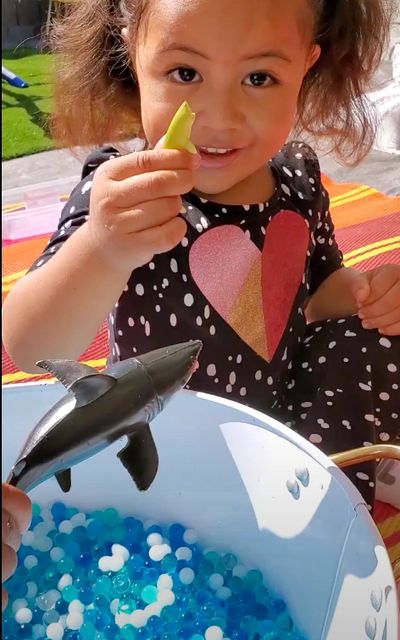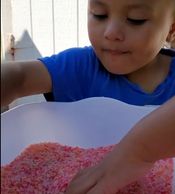
Meet Sesilia
Sesilia is an adventurous little robot that loves to come up with new and exciting ways to learn and play.
Sensory Play with Sesilia

One of the earliest ways that children learn about the world around them is through their five senses: sight, smell, sound, touch, and taste.
The "Sensory Play with Sesilia" experience was created to encourage children to explore and learn using their five senses. With engaging activities like making slime and creating a sensory bottle, sensory play can encourage meaningful learning and an early interest in STEM.
Sensory Play and Early Childhood Development
Because the early years are so critical to brain development, strengthening the five senses through sensory play can build a foundation of early learning experiences. By engaging in hands-on activities, children can improve their fine motor skills, the movement skills needed to do small tasks like writing and holding small items. When children engage in sensory play activities with others, they are learning essential skills like collaborating, communicating, and solving problems. Sensory play can also teach children how to use effective self-regulation strategies.
STEM Exploration Through Sensory Play
At PIEFEST, we are committed to engaging Pacific Islander children and youth by providing access to resources that will continue to nurture and encourage children’s interest in STEM. We believe that sensory play can provide the building blocks for STEM skills, nurturing their interest in STEM as they grow into adulthood.
Through sensory play, children are naturally practicing STEM concepts like making inferences, testing hypotheses, and trying different materials. Because sensory play is so open-ended, children can be creative - one of the most important aspects of STEM exploration. These early experiences can get children interested in STEM long before any formal STEM instruction.
At home sensory play activities
CREATE A SENSORY BIN
DESIGN A SENSORY BOTTLE
DESIGN A SENSORY BOTTLE

One of the most popular sensory play activities is a sensory bin. Fill a small container with items that your child can play with and touch: pom poms, water and soap, dry pasta, corn, confetti, tissue paper, shaving cream, water, or sand. As your child plays with items in the sensory bin, help your child practice his or her observation skills by asking “What does it feel like?” and “What do you notice?”
DESIGN A SENSORY BOTTLE
DESIGN A SENSORY BOTTLE
DESIGN A SENSORY BOTTLE

A sensory bottle is a colorful and calming activity for young children. Fill a clear plastic bottle with objects like glitter, bouncy balls, or dry food (corn or rice). Next, add water to make the objects float. Encourage your child to move the bottle and share his or her observations. You will be amazed by how entertaining this activity can be!
COOK TOGETHER
DESIGN A SENSORY BOTTLE
EXPLORE IN NATURE

Getting your child involved in cooking can be a fun (and rewarding!) activity for the whole family. For example, baking cookies can be a great sensory play activity. Have your child compare the dough before and after it’s in the oven, an early and delicious science experiment!
EXPLORE IN NATURE
TEST DIFFERENT SOUNDS
EXPLORE IN NATURE

Nature is full of opportunities for sensory play experiences. For example, you can collect pebbles and talk to your child about the differences in texture. Try collecting all green items or all red items to develop your child’s sense of sight.
MAKE HOMEMADE SLIME
TEST DIFFERENT SOUNDS
TEST DIFFERENT SOUNDS

Homemade slime is a tactile sensory play activity that is fun for the whole family. Learn about how to make slime and the science behind it with PIEFEST’s slime activity guide.
TEST DIFFERENT SOUNDS
TEST DIFFERENT SOUNDS
TEST DIFFERENT SOUNDS

To develop your child’s sense of touch, place different objects in a box or small container that your child can’t see inside. Shake the box and ask your child to tell you what he or she hears and compare the sounds. Next, have your child do the same for you!
